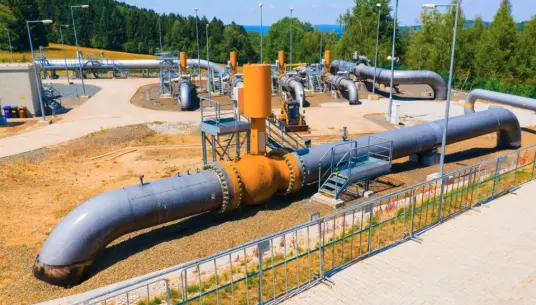Swift action to assert energy dominance
Nine months into its term, the Trump administration has acted swiftly to reshape how the US produces, uses, and exports energy. On day one of his presidency, Trump signed a series of Executive Orders to promote energy dominance. Energy Secretary Chris Wright subsequently announced the goal of delivering affordable, reliable, and secure energy. To achieve this, fossil fuels are being prioritised. This includes opening more federal lands for drilling, expediting liquefied natural gas (LNG) projects, and rolling back more than 30 environmental regulations.
Some clean energy technologies also made it into the administration’s core energy strategy, such as nuclear and geothermal, both of which are receiving incentives and regulatory streamlining. But other clean energy sources face much greater challenges. In July, Congress passed the One Big Beautiful Bill Act (OBBBA), significantly reducing the availability of tax credits for technologies such as wind, solar, EVs, and hydrogen.
The Trump administration’s vision for US energy dominance may not include every form of energy, but its ambition to win the AI race clearly demands it. Power demand from AI-driven data centres is projected to surge this decade, likely exceeding 10% of the national power demand by 2030, up from 4% today.
To meet this demand, the US needs to pragmatically leverage all available energy sources.
Fossil fuels alone cannot do the job due to supply chain constraints, rising equipment costs, and, in some cases, unfavourable economics.
Solar and wind would therefore help expand power capacity, though their contribution would be more limited than previously projected.
Nuclear and geothermal roles will increase over time, too.
Investing in clean energy can also, in the long run, maintain US competitiveness against China, which is already dominating the manufacturing and export of many technologies.
Natural gas and coal face constraints in ramping up power capacity
The energy demand from AI-driven data centres is placing enormous pressure on the power sector. To meet this challenge, the sector must expand installed capacity, upgrade the grid and make it more flexible. Natural gas and coal, in the short term, would play a stronger role in providing an adequate supply, but these two sources alone would not be sufficient.
Natural gas has emerged as a favoured generation source to power the AI growth due to its low cost and ability to deliver uninterrupted electricity, but the ambition to increase natural gas power capacity faces major challenges. The production backlog of utility-scale Combined Cycle Gas Turbines (CCGTs) until the end of the decade has led to higher production costs of gas-fired electricity. Rystad Energy observed that a typical CCGT plant’s capex has frequently surpassed $2,500KW since the first quarter of 2025 alone. That’s up from $1,200-1600/KW between 2023-24 and just $800-1,000/KW in the seven years between 2015 and 2022.
The capex is under pressure to continue trending higher, with buyers maintaining a high willingness to pay the premium. Data centre companies, hoping to expand their businesses quickly, are turning to alternatives such as simple-cycle gas turbines (including aero-derivative turbines) and reciprocating engines. Albeit less efficient, these alternatives are smaller, more agile systems that can quickly ramp up and down to meet the operational power requirements of AI training data centres. This can moderately assuage the CCGT's shortage in the short term, though gas-fired power is still poised to fall short of the desired supply.
The administration is also aiming to revive the coal industry, recently announcing $625m of funding to help retrofit and recommission coal-fired power plants. This would extend the lifeline of coal assets, especially on the back of rising electricity demand and constraints on power capacity growth from natural gas and renewables. This year, US coal production has increased by more than 6%. Several coal-fired power plants are also being kept online past their expected retirement dates.

However, coal is still in structural decline, and the administration's supportive policies are unlikely to return it to its golden days. The levelised cost of electricity (LCOE) from coal in the US is now roughly $71-173/MWh, higher than $48-109/MWh for natural gas from combined-cycle gas turbines and $50-131 for utility-scale solar with battery storage, according to Lazard.
The spending needed to upgrade coal’s ageing infrastructure or to keep an uneconomic coal power plant from retiring means the industry will likely not see a material production boom.
Weaker-than-projected role for renewables, but they are still needed
Given the limitations of natural gas and coal, renewables need to – and are indeed – contributing to expanding US power capacity. Following the massive project development spurred by the Inflation Reduction Act, solar and wind are expected to remain the primary drivers of capacity additions in 2025 and 2026.

Nevertheless, the potential for solar and wind to boost the US electricity supply has become more constrained due to recent policy changes.
As discussed in a previous article, the OBBBA would increase the cost of solar and wind projects when the tax credits phase out, though some can still be cost-competitive with natural gas. Developers have been actively working to safeguard their projects by meeting the ‘start of construction’ deadline and the ‘foreign entities of concern’ (FEOC) requirements. Larger companies with ample resources are better positioned to comply. They can demonstrate ‘start of construction’ on time, either by initiating physical work or incurring at least 5% of the cost by 2 September 2025. Some have also met the ‘continuity of construction’ test by consistently purchasing equipment such as transformers.
Regarding the FEOC requirements, some had begun pre-emptively shifting away from heavy reliance on China as early as a few years ago. Therefore, these companies’ existing pipelines should be mostly unaffected. But smaller companies may face greater challenges, and we could see increasing consolidation as the impact of OBBBA becomes more pronounced.
We have also argued that without tax credits, solar and wind companies can still enhance profitability through securing higher power purchase agreement (PPA) prices and developing storage technologies. But so far, developers’ focus is on grandfathering and executing existing projects, with limited attention to expanding pipelines. This means that, in the short term, installed capacity can still grow steadily, but once the tax credit deadlines pass, capacity additions will slow, effectively squeezing the industry’s multi-year development marathon into a sprint.
There have also been signals of an early pivot in clean energy investment. Although US clean investment registered a 5% year-over-year increase during the first half of 2025, the clean energy manufacturing investment subcategory experienced a two-consecutive-quarter decline. Notably, in Q2 2025, clean energy manufacturing saw, for the first time, a higher volume of investment cancellations than announcements. This slowing trend is expected to persist, with possibly lower appetite for new investment and more cancelled projects.

But again, the demand for renewable power will continue to grow. Corporate America will be incentivised to pursue more renewable power to improve their operations, with a recent survey showing that 87% of US firms are maintaining or increasing sustainability spending in 2025.
Additionally, the Department of Energy (DOE) recently finalised a $1.6bn loan guarantee for American Electric Power (AEP) to upgrade 5,000 miles of transmission lines across Indiana, Michigan, Ohio, Oklahoma, and West Virginia. This will benefit renewables by enabling more efficient power transmission across the Midwest. While it’s unclear if other transmission projects will receive funding, the DOE’s support for AEP shows its practical approach to improving grid reliability and reducing costs.
Nuclear's outlook hinges on up-scaling and supply chain management
Nuclear arguably has the most momentum today – driven not only by tech companies’ betting on it as clean baseload power, but also by the US government’s support that spans the Biden and second Trump administrations.
Following a spike in 2024, AI-driven data centre companies have cumulatively announced 28GW in capacity from Q1 2023 to Q2 2025 for their operations. Investment has surged accordingly. For instance, there has been almost $10bn in public and private investment in novel small modular reactor (SMR) technologies in the US since 2019.

However, the projected higher contribution of nuclear to the US power mix remains a medium to long-term story. Now, all the additional nuclear capacity expected to become available in the next year or two will be from restarts of idle traditional plants. No SMR plants are running in the US today; a handful of SMR projects are under construction, including Holtec's "Mission 2030" in Michigan and TerraPower's Natrium Project in Wyoming. And while estimates vary, the average LCOE for SMRs remains substantially above that of many existing energy sources. Holtec’s pledged construction timeline, if successfully implemented, would bring the first SMR commercial operation to the US in 2030.
Moreover, both traditional nuclear plants and SMRs need adequate supply chain management to consistently contribute to power generation. Both utilise nuclear fission technology, which generates energy by splitting heavy atoms like uranium. The US’s domestic uranium production has been in recovery in recent years, with the volume in the first two quarters of 2025 already surpassing the full year’s volume in 2024. But the US is still heavily reliant on imports, with domestic production only able to satisfy 8% of its needs.

But even with imports, there can still be a uranium supply gap, possibly mounting to 20.5m pounds of U3O8 equivalent in 2030. With limited potential to ramp up domestic uranium production quickly, the US would rely more on imports and be subject to global availability and pricing. In September, President Trump exempted uranium from tariffs, providing some relief to the nuclear industry. Nevertheless, the global uranium market will only become more competitive as countries worldwide accelerate investment in nuclear energy.
Fusion, another type of nuclear technology that shows great potential but is under development, also faces supply chain challenges. Unlike fission, nuclear fusion generates energy by smashing together two atoms (typically deuterium and tritium, two isotopes of hydrogen). Tritium exists in tiny quantities, with current world production totalling less than 4kg/year. Unlocking closed-loop tritium processing is therefore crucial for the technology’s development. Nuclear fusion also faces other challenges, such as the design of qualifying materials and the integration into the power system. The DOE’s new fusion roadmap, unveiled in October, aims to solve exactly those challenges and forge a path to commercialisation in the 2030s.
'Drill baby, drill' – but for geothermal
Geothermal is also gaining traction under both the Biden and the second Trump administrations, thanks to its ability to deliver reliable, round-the-clock clean energy. Across North America, geothermal attracted $1.7bn in public investment in Q1 2025 – already 85% of the total funding seen in all of 2024.
The US leads the world in installed conventional geothermal capacity – about 4 GW – thanks to favourable geology in the western states. However, conventional geothermal’s geographic limitations have spurred the development of advanced technologies like Enhanced Geothermal Systems (EGS) and Closed-Loop Geothermal Systems (CLGS).
The US is well-positioned to scale EGS, leveraging transferable skills from fracking in the oil and gas industry. Indeed, EGS developer Fervo, with ex-oil professionals on board, is building a 400 MW site in Utah by 2028 after a successful pilot in Nevada in 2023. Progress is also underway in CLGS: XGS Energy has successfully completed 3,000 hours of field-testing, paving the way for commercial construction.


























































































